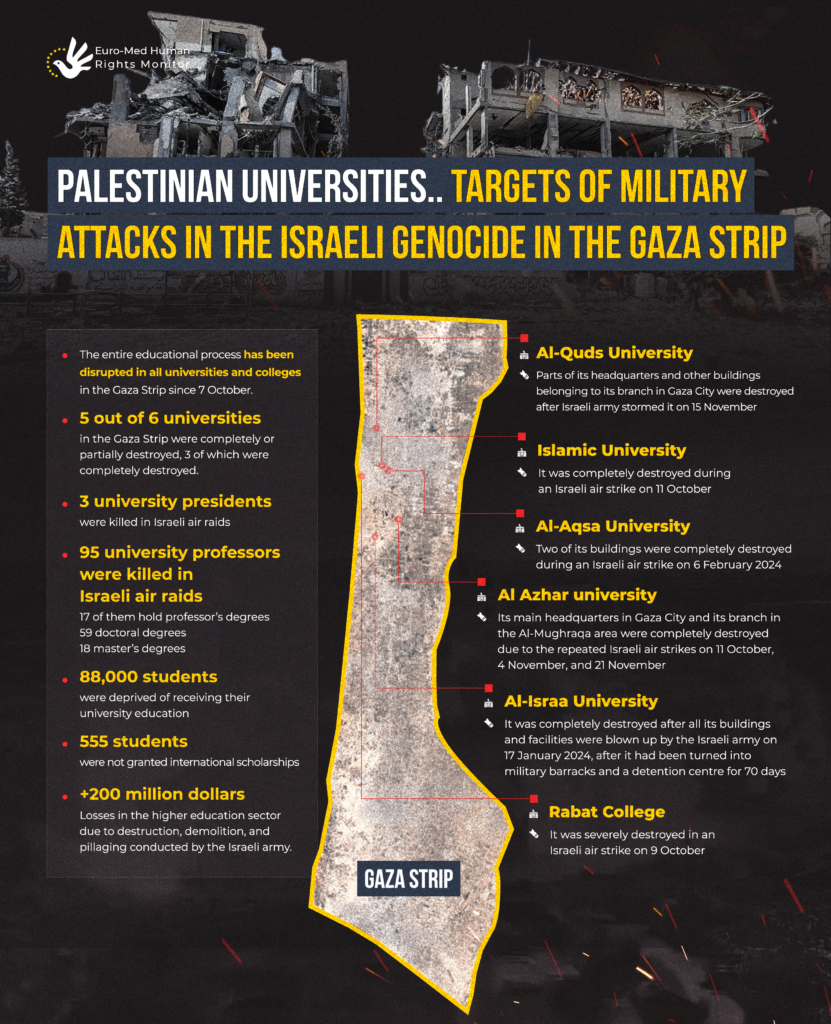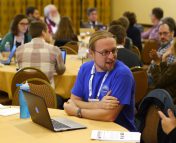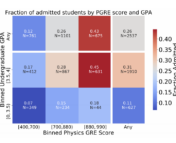Astrobites is first and foremost a student-run, independent collaboration. Our statement of inclusivity recognizes that science does not operate in a vacuum, and as such, we have a duty to recognize and address current events deeply impacting the lives of students in higher education. Following intensive internal discussions about how to cover and respond to the escalation of Israel’s ongoing occupation of Gaza, Astrobites has decided to highlight the impact on higher education, including the destruction of infrastructure and devastation of what was a blossoming astronomy community in Gaza. Astrobites is an editorially independent organization and a writing collaborative; which means that this post does not reflect the views of any other organization we are associated with and does not necessarily reflect the views of every individual within our collaboration.
The Night Sky Over Gaza
“Boredom, the blockade, and all the problems here are no match for something as beautiful as a star suspended in space,” Ibrahim Saad, a teacher at al-Aqsa University’s Center for Astronomy and Space Sciences in Gaza, told Undark in 2020. Even under some of the Earth’s most heavily surveilled skies, in between drone flyovers at all hours of the day and night, the awe-inspiring power of astronomy persisted in the Gaza strip. Now, the budding astronomy and astrophysics community, like all communities currently in Gaza, is facing an existential risk. Rather than looking up to see stars suspended in the blackness of space, the citizens of Gaza now watch the skies for signs of incoming munitions, which have already taken the lives of over 30,000 people, the vast majority of whom were civilians—shop-keepers, artists, teachers, parents, children, and yes, astronomers.
Despite largely being cut off from the international university community through 15 years of the Israeli blockade, scientific curiosity and academic achievement continued to persist in the Gaza strip. Education is a key part of Palestinian society, deeply entrenched in its cultural identity of resistance and resilience. The literacy rate among Palestinians is an astounding 97.7%, one of the highest rates in the world, and Palestinian scientists have contributed to many of humanity’s greatest accomplishments in space, from leading experiments for the Apollo 11 mission to helping design the Mars helicopter Ingenuity. In recent years, an increasing number of young people in Gaza have been picking up astronomy textbooks and pondering outer space habitats, thanks to the combined efforts of Palestinian scientists and international organizations supporting education in Palestine.
In 2012, the United Nations established a UNESCO Chair in Astronomy, Astrophysics and Space Sciences position at the Islamic University of Gaza, with the objective to “promote teaching, research and outreach activities in astronomy, astrophysics and space sciences throughout Palestine.” This position was originally taken up by Dr. Suleiman Baraka, who studied theoretical physics at Al-Quds University in Jerusalem and the Islamic University of Gaza before completing his PhD in astrophysics at Pierre and Marie Curie University in France. After his graduate studies, Baraka worked at Virginia Tech on NASA missions related to the Earth’s magnetosphere and other space weather phenomena. Baraka returned to Gaza shortly after his 11-year-old son was killed by an Israeli airstrike during Operation Cast Lead. In the immediate aftermath of this personal tragedy, Baraka turned to astronomy outreach and the promotion of education, working with various international officials to navigate the difficult process of bringing an educational telescope into Gaza. More than being just an instrument for research, Baraka told Middle East Eye in 2016 that a telescope “is an important tool through which to feel freedom and sense mobility from our tiny place on the ground.”
Despite the difficulties, a dedicated group of students and researchers led by Baraka has cultivated a vibrant community focused on studying the stars and celestial bodies. These young stargazers carefully transport telescopes through Gaza neighborhoods, navigating around electrical wires and Israeli drones, to reach rooftops where they can peer into the cosmos. While constrained by severe restrictions on movement and trade, Gazans have defiantly embraced astronomy over the past decade, forming hobby groups and societies, and even establishing the aforementioned al-Aqsa University Center for Astronomy and Space Sciences in Gaza with the help of Dr. Baraka. In the same 2016 article, Baraka emphasized “I have my message, and that is to establish the educational infrastructure for astronomy in Palestine […] I want to teach these children peace and love – nothing else […] We must see past the drones, and reach for the stars.”
The development of this chair position and the associated expansion of astronomy and physics outreach in Palestine has been followed by a general increase in both public interest in astronomy and an expansion of educational opportunities for students in the country. In 2016, the inaugural Palestinian Advanced Physics School (PAPS) was held in the West Bank, hosted by the Arab-American University in Jenin. The program, which was also held in 2017, 2019, and 2022, aimed to “provide master level students with an overview of exciting recent developments in modern physics that would normally not be part of the regular curriculum at their home universities.” Lecture slides from the 2017 school feature a variety of topics that should be familiar to many Astrobites readers: the development of general relativity, the discovery of the expansion of the universe, dark matter, gravitational waves, and so on. However, year after year, students in Gaza were denied travel permits to attend the schools in person, despite the school typically taking place a mere 80 km from the border. In the face of this inequity, Gazan students persisted in their studies by attending virtually, sometimes resorting to sending their homework via cell phone images to the instructors. Frequent PAPS co-organizer Dr. Nabil Iqbal recently shared that a former attendee communicated to him “if this is the end for her, she wants me to remember that she wanted to be a physics student, and teach others to love it as much as she does.”
A love for astronomy has not just been limited to those within the academic sphere; there is a very active Palestinian Astronomical Society which offers summer camps and regularly updates their Facebook page with photos of the moon, facts about meteors, and so on. In the face of blockades and travel restrictions, local astronomy enthusiasts like Jumana Koueider and Ibrahim Saad have also managed to construct their own telescopes and laboratories out of what often amount to spare parts. On top of this, there exist nonprofit organizations like Nova, which are dedicated to astronomy and space science in Palestine. However, many of these organizations’ activities have been historically inaccessible to students in Gaza, once again due to heavy restrictions on freedom of movement from Gaza to the West Bank where many of these organizations are based. This makes the relatively recent advent of public stargazing events at Al-Aqsa University, or the development of programs like Gaza Mars Ambassadors (GAM) even more vital to building up an astronomy community in the isolated region. The existence of these programs speaks to the passion and dedication of Gazan astronomers.
A Siege on Education
Despite the inspiring efforts of many in Gaza to produce a flourishing astronomy community, Israel’s relentless attack on the educational infrastructure in Gaza as part of their military campaign has now put all academic communities and places of learning in the territory at risk of complete destruction. According to the United Nations Office for the Coordination of Humanitarian Affairs (OCHA), over 60% of Gaza’s educational buildings have been either destroyed or severely damaged by Israeli bombing or other military operations, including schools run by the UN Relief and Works Agency (UNRWA). On top of this, 30% of all buildings have been moderately damaged or destroyed as of January; this destruction extends to schools, libraries, archives, museums, and publishing houses in Gaza. Gaza’s higher education system is now nearly obsolete, as most universities have been partially or fully destroyed, including the total destruction of Al-Israa University, which Israel bombed on January 17th 2024 after having been turned into a detention center for 70 days. The bombing campaign also targeted Al-Aqsa University, with numerous campus buildings being bombed on November 4th, 2023. Al-Aqsa University is home to the Center for Astronomy and Space Sciences in Gaza, where students and the general public alike used to enjoy rooftop stargazing sessions. Since November 6th, all schools and universities in Gaza have been shut down. This amounts to 625,000 students with no access to education, despite a previous 95.4% student enrollment in basic education. Article 26 of the Universal Declaration of Human Rights states that “everyone has the right to education,” and yet, this right has been taken from every student in Gaza for the past four months and counting.

Not only has much of the physical infrastructure supporting education in Gaza been destroyed in the past five months, but thousands of academics have tragically been killed. Since October 7th, Israel has killed over 5,000 students, 240 teachers, and 94 University professors. This number falls in the larger context of 31,819+ reported killed and ~73,934 reported injured as of the time of writing this article, with those numbers expected to grow. According to experts like Euro-Med Monitor, many of these intellectuals have been specifically targeted by the Israeli army, taking not only their lives, but also the lives of their families and friends. One of these professors was Dr. Sufyan Tayeh, the most recently appointed UNESCO Chair in Astronomy, Astrophysics, and Space Sciences in Gaza. Dr. Sufyan Tayeh specialized in “electromagnetics with a specialty in photonic crystals and biosensors,” and was ranked in the top 2% of researchers worldwide. He was also the president of the Islamic University of Gaza, which was heavily damaged by Israeli airstrikes on October 9th, and whose medical school was detonated by Israeli forces on December 10th. On December 2nd, Dr. Sufyan Tayeh was killed alongside his family in the Al-Falouja area. One of his last messages to a colleague at the University of Waterloo was to “tell the world this is happening to us.”
The Next Generation of Palestinian Students
What of the next generation? The destruction of the education system in Gaza is only one facet of the devastating conditions that Palestinans in Gaza are forced to contend with. The United Nations Conference on Trade and Development has said that even if the conflict ended today, it would take decades to return to the welfare levels prior to October 2023, (when its GDP ranked 142nd), and even longer to achieve the socioeconomic standing of Palestine prior to the blockade of Gaza in 2007. Rebuilding is not possible until people are able to live. The United Nations Office for the Coordination of Humanitarian Affairs reported that 25% of the population of Gaza (576,000 individuals) is one step removed from famine. This is a man-made famine, as the Israeli government enforces tight restrictions on the flow of aid into the areas they occupy. 500 trucks of supplies used to enter Gaza daily, whereas now the daily average is closer to 100. It is well documented that starvation impacts child growth and development, and the longer the forced mass starvation continues, the worse conditions will become, including further loss of life. In the end, it is the Palestinian children in Gaza who will suffer the most from this conflict, as nearly half of Gaza’s population is under 18.
As astronomers, we must raise our voices when the futures of our colleagues (present and future) are stripped away from them. As humans, we must take action when we bear witness to extreme violence and cultural erasure of our fellow humans.
Further Engagement
The genocide in Gaza demands our attention and our action. As astronomers and members of the global scientific community, we cannot ignore the immense suffering and devastation inflicted upon our colleagues. It is crucial that we educate ourselves and engage in meaningful discussions within our departments and cohorts. We also have to reflect on our own roles and complicity in this tragedy. US-based scientists especially should consider how their work perpetuates harm caused by collaborations between academia and the military.
Further resources and possible actions:
- Learn more about the ongoing scholasticide in Gaza.
- Demand a permanent ceasefire. Consider signing a petition, like those from Oxfam international and amnesty international, and contact your representatives.
- Donate to UN organizations and/or donate esims to Gaza.
- Share and participate in programs working to accept Palestinian scholars into their university programs and help them complete their degree:
- Palestinian Students & Scholars at risk (Canada)
- Fonds de recherche du Québec (Québec)
- Hope Fund (United States)
- Help fund Maram Albashiti’s physics studies in Turkey.
- Uplift the voices and work of Palestinian academics. Join Scientists for Palestine and follow them on X for updates. Read articles written by Palestinian academics, such as those by Drs. Tayeh and Baraka mentioned earlier in this article.
Featured image credit: Astrobites logo




